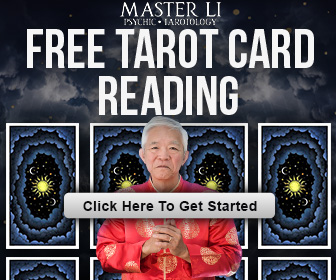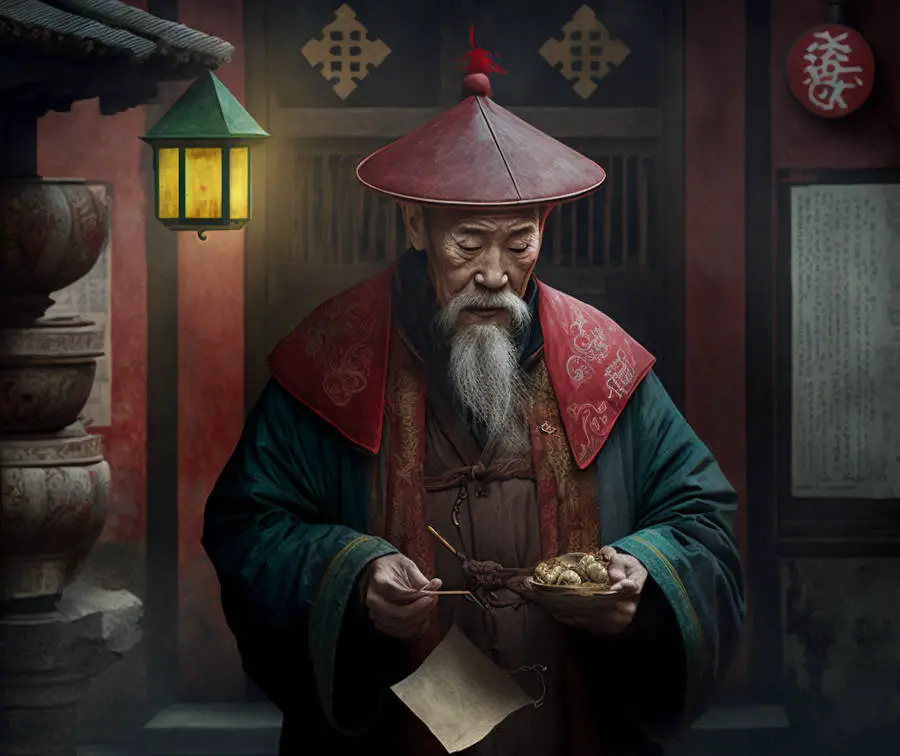
Fortune-telling is an important part of Chinese social life and culture. Suan Ming (算命), or fate calculation, has a long history in China, with roots in divination and primordial religion. Nevertheless, many aspects of it have persisted to the present day and continue to be quite popular, even among young people.
Whatever method is used, the foundation for Chinese fortune-telling is a profound belief in fate: we are all born with diverse fates since every one of us is a unique individual. There is much beyond our control, and as a result, fate is neither knowable nor amendable. Only people with special abilities might be able to catch glimpses of it and see patterns in it.
Even so, free will is important because Chinese fortune-telling isn’t just about predicting the future like Western astrology is. Instead, it’s about learning one’s fate and then acting on the strengths and timing of this information to get the best possible result. Therefore, it would be up to you to utilize the power of your destiny to your benefit. In fact, China’s long history is full of both heroes who were able to take control of their lives and succeed and people who wasted their good luck by going against the flow of fate.
The ability to ride the ebb and flow of fate and utilize seemingly random events in life to one’s advantage is one of the characteristics of a really wise man in Chinese culture. This notion derives from the Taoist principle of Wu Wei, or “effortless action”.
In Chinese culture, fortune-telling is valued and seen as an important part of social and business life. The Chinese, in general, have a strong belief in destiny, and because of this reason alone, they have a variety of techniques for banishing bad luck and bringing success and wealth into one’s life.
At the same time, Chinese fortune tellers, known as suanming shifu (算命师傅) or mingli shi (命理师 ), have a function similar to that of a management consultant or a psychologist in the West. This is mostly because fortune tellers give entrepreneurs and business owners advice on different investment options and decisions, and almost everyone else wants to hear what a fortune teller has to say about their lives.
In an atmosphere free from judgment and other uncomfortable situations, they also talk about and address personal issues. Fortune telling is also valued for its entertainment value. The Chinese enjoy fortune-telling and consider it to be just as exciting as live magic.
Fortune tellers use personal information such as your name, date of birth, and physical characteristics to forecast your future and offer advice on how to stay out of bad luck. On the streets, the most popular fortune-telling methods are mianxiang (面相) and shouxiang (手相), which foretell your future by reading your facial characteristics and palm, respectively. These street fortune tellers will generally have a map on the ground or will approach you and request to look at your hand.
However, in addition to these methods, there is a wide variety of fortune-telling techniques, which we will discuss below. But first, let’s take a look at the history and origins of Chinese fortune-telling.
Historical origins of Chinese Fortune-Telling
Divination has been a part of Chinese culture for a long time. Its exact beginnings are unknown because there are no records, but it was definitely a part of life in ancient China. Chinese fortune-telling, like other types of future prediction, has its roots in divination, which was used in an era when people thought that nature was in control of their fate and that life was incredibly unpredictable.

There are several variations of Chinese fortune-telling. The majority of them originated in the I-Ching, also known as the Book of Changes. This was one of China’s oldest divination writings, dating back to 1,000 BC, and was heavily influenced by Taoism and Confucian thought. Later on, the ancient methods described in the I-Ching were formalized as the complex systems of the Five Elements, Heavenly Stems, and Earthly Branches matured throughout China’s lengthy history.
The earliest reports of divination practice refer to it as a method for “solving doubts.” There were two well-known divination methods: bǔ 卜 (on tortoise shells) and shì 筮 (on milfoil stalks). Since the Shang and Zhou dynasties, these practices have been sanctioned by royal practice (1600–256 BC). As a result, it is fair to claim that such activities must have existed for some time before gaining significant popularity.
Fortune-telling in the modern sense did not emerge until the Tang dynasty (618-907) when fortune-tellers began to use a person’s birth year, month, day, and hour to forecast their fate. This practice rapidly became a popular activity that many, not only professional fortunetellers, learned and practiced, frequently for amusement.
The divination of the xiang 相 type, however, which was based on how things are looking (like body parts, animals, etc.), was sometimes criticized (the Xunzi, “Against divination”). This kind was apparently used in medical and veterinary procedures, as well as in matchmaking and marketing decisions.
One notable truth is that Jesuits considerably refined Chinese almanacs. The Ming administration (1368-1644) embraced the Jesuits’ adaptation of Chinese calendars and kept the traditional method of forecasting whether a day was favorable or unfavorable in the new calendars that the Jesuits developed.
In the Ming era, fortune tellers used a variety of strategies to grow their businesses. Some of them would travel on foot, going from one street to the next while carrying a placard identifying their area of expertise. The sixth book in the series, “Stories to Caution the World” (Aff.link), depicts a fortune teller who walks alone on the road. The fortune teller was able to get the client’s attention by displaying a banner that said, “Divine Foresight.” At sites with a lot of people, such as the city entrance and temples, other fortune tellers from the rural areas would also put up booths.
As usual, the dynastic chronicles have a number of stories about how divination was used to reach personal or political goals.
Fortune-telling is still a big part of everyday life in China, even if it’s just for peace of mind. Many individuals seek out a Feng Shui professional to sketch out the most auspicious arrangement of their furniture while moving to a new property, for example. They might even hire a fortune teller to name their child after the aspects of their birthday.
Choosing a wedding date will always require consulting an old almanac to see which day and year would provide the newlyweds with the highest possibility of marital bliss. Major corporations are particularly worried about their financial situation.
In China, unlike in the West, fortune-telling is still popular because the idea of fate is so deeply rooted in the Chinese belief system, which is a mix of religious, philosophical, and cultural ideas.
Chinese Ways to Predict the Future
The following are the most popular ways of Chinese fortune-telling found across China:
Chinese fortune sticks, or Chi-Chi sticks
Chinese fortune sticks, also known as Kau Cim (求籤), are made out of a bamboo cylinder and a bundle of sticks with various Chinese characters written on them (usually 100 sticks).
People who are looking for answers through kau cim will select the proper temple, make incense offerings to the primary god, and then cleanse the bamboo kau cim holder by rotating it around the incense holder three times. The bamboo kau cim sticks are carefully combined by hand, and the inquirer kneels in prayer with their palms on the holder.
As they shake the holder, they must ask the question or consider the problem for which they are looking for solutions; this must be done quickly, without changing the subject or pausing in the middle of the query. Typically, shaking causes one kau cim stick to fall out of the holder and onto the ground; if more than one stick falls out, shaking is repeated.
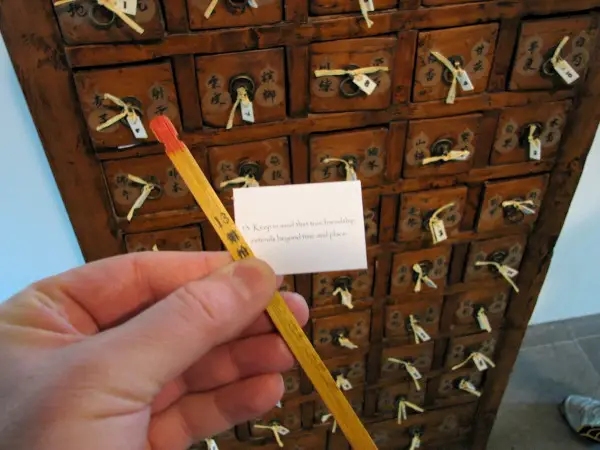
Each stick has been assigned a number, which corresponds to a certain response to the questions. The assigned number refers to one of the one hundred textual oracles that contain an answer. The question is then answered by what is written on the piece of paper.
Inquirers might interpret it themselves, but because the content is in old Chinese and presented as poetry or a short narrative, it is frequently taken to temple priests or fortune tellers for clarification. Based on the short poem, the fortune-teller will try to figure out how the gods will answer the question. For this service, a small fee is charged.
The two most well-known temples for kau cim fortune telling are Wong Tai Sin Temple and Che Kung Temple, where it’s believed that the gods are listening and the fortune tellers are excellent interpreters.
Related reading: Chinese Fortune Sticks: History, Meaning, and How They Are Used
Palmistry – Palm Reading
The practice of shuxiàng (手相), or reading your future from the palm of your hand, involves analyzing the layout of your palm lines to estimate your personality traits and the possibility of finding love and happiness in the future.
Palm reading, like palmistry in Western occult traditions, is a cultural craft that allegedly has its roots in Hindu astrology and has been extended to China, Tibet, and farther west to Egypt and Europe.
The following are the most prominent lines on your palm:
- Life line: This line’s length and depth indicate your chances of living a long, healthy life.
- Head line: Your personality and thinking clarity are impacted by this line. The greatest line is one that neatly traverses your palm. If yours has a lot of fine lines, you might have trouble making important decisions.
- Heart line: This line reveals how you see the love and if you are a faithful partner. If this line is less visible on your palm, it may indicate that you do not place a high value on love and that other parts of life seem to be more important to you.
- Fate line (Career line): This line represents your professional side. If it rises vertically, you are bound for a remarkable climb in your field.
- Marriage line: This is a small line that begins directly under the little finger and extends over the love line. It is a reflection of a person’s love connections and marriage.
Your sun line, children line, money line, and health line are all minor lines. The form of the fingers and the entire hand, the color and texture of the skin, the size of the knuckles, the fleshiness of the palm and its mounds, and other similar traits all play a role in the reading of the person.
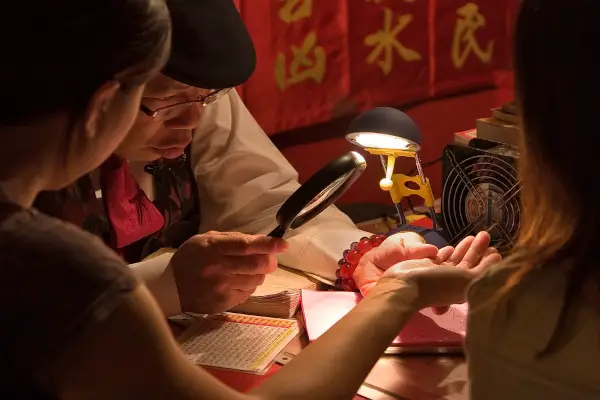
Physiognomy – Face reading
Face reading (面相), like palm reading, makes use of the anatomy and physiology of your face to determine your fate and fortune as well as your personality’s strengths and flaws.
Taking into account your forehead, eyes, brows, nose shape, lips, ears, cheeks, and jaw, your face provides a plethora of information about your future health, talent, financial condition, luck, and status at various phases of your life. The top area of the face is believed to symbolize youth, the middle section of the face is thought to represent middle age, and the lower portion of the face is considered to represent old age.
Physiognomy in China goes all the way back to the Northern Song era. This technique is used by fortune tellers as well as traditional Chinese medicine practitioners. Rather than fortune-telling, it is based on the art of observation. Just as we can tell whether a fruit is healthy or malnourished, if it has been eaten by a worm inside, or if it is not yet ripe, a face reader can detect how a client lives their life and if it is in accordance with their fate.
According to a Chinese saying, “everything in one’s heart is reflected on one’s face,” the face-observations tellers will provide information about the client’s past, present, and future.
Here are a few distinguishing features to look for in the mirror:
- A full forehead is a sign of financial success, especially from a high-paying job, likely in the public sphere.
- If a person’s ears are lighter in color than their face, it means that they will have a smooth path to the top of their field.
- A person with bright eyes will likely receive assistance from higher-ups anytime they need it, and will also be fortunate in marriage.
- People who have their cheekbones peak at the midpoint of their nose are more likely to excel in their career. Cheekbones are a sign of strength and responsibility.
- Those blessed with a straight and high nose bridge have a greater chance of achieving fame. This characteristic is particularly admired in guys.
- Α round chin is a desirable trait in women, and it is thought to represent the benefits of a happy and prosperous marriage.
A person’s fate is said to be influenced by the shapes of their features; hence, it is thought that traits that are thought to bring bad luck can be changed in order to change one’s future. Because of this, face readers often tell their clients that they should make their eyes look bigger, get rid of moles and beauty spots on certain parts of their faces, or do other minor cosmetic surgery to change their luck for the better.
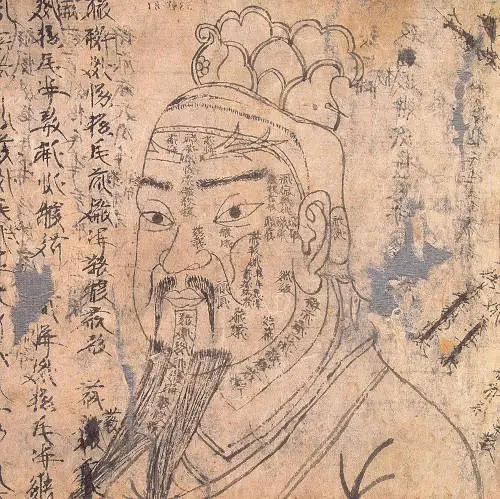
The Four Pillars of Destiny
Bazi (八字), or “eight characters” in Chinese, is the most common and sophisticated form of Chinese fortune-telling. It’s also known as the “Four Pillars of Destiny.” This technique is based on the Heavenly Stems and Earthly Branches calendar system. Each year, month, date, and hour is given one character from the 10 Heavenly Stems and one character from the 12 Earthly Branches, according to these two systems.
As a result, a person’s birth date may be represented by eight characters. According to the Five Elements Theory, their fate may then be estimated by evaluating the interaction between these characters and the elements with which they are related.
This approach may be used to determine one’s general outlook on work, family, love, health, and pretty much anything else in life. According to several schools of thought in China, a person’s good fortune depends on how well their lives are balanced.
Bazi also analyzes a person’s “major fortune” over the course of decades. Unlike the fixed calculation of fate, this calculation is dynamic and takes into account both the qualities of the person and the circumstances of the outside world. If these conditions are beneficial for a person, their fortunes will likely increase over the decade compared to what their birth date indicates, although the opposite will also be true.
Additionally, Bazi looks at your luck for each year. A Bazi fortune teller will examine your zodiac animal to see if it conflicts with or complements the Tai Sui deity of the current year. A pretty good Bazi report will be thorough, likely be quite long, and should be maintained and used as a reference as you go through life.
The Pillars concept dates back to the Han dynasty, but it wasn’t until the Tang dynasty that Li Xuzhong formalized it by dividing time into two sexagenary cycles, or 60-year groups each cycle.
During the Song dynasty, a man named Xu Ziping enhanced this by including birth time in the categories as well, therefore forming the fourth pillar by which a person’s fate might be determined. This is the reason why this kind of divination is sometimes called Ziping Ba Zi (子平八字) after this fortune teller.
In addition to divining fortunes, one’s Ba Zi may be utilized in occult ceremonies to lay a curse or a hex. Because of this, some Chinese people are still hesitant to give strangers their whole Ba Zi.
Since a person’s date of birth and palm never change, Bazi and Shouxiang are typically employed to evaluate one’s past and future.
Check out our “Free Chinese Literature Library”. We have compiled some great free resources, about Chinese literature, for your research.
Geomancy (Feng shui)
Undoubtedly, feng shui is among the mysterious arts of China that are well-known to foreigners. The feng shui master, also called a geomancer, mostly looks at homes, businesses, tombs, and other important places to see how their location and placement fit and balance with the order of the universe.
One of the most important things a geomancer knew was how to use a compass (luopan) to figure out location and time. A standard compass has thirty-eight rings that intersect with “five elements,” “twelve branches,” “nine stars,” and “ten stems”; so a geomancer must determine the specific sign on the compass that can reflect the nature of a location. This will reveal to them if the location is inherently unlucky or whether its fortune may be enhanced by adding redesigns or furnishings that can counteract any negative energy.

When a geomancer looks at a house or business, they often suggest putting in precious stones like jade or amethyst crystals to improve the energy, pixiu figures to bring in money, or screens and other dividers to change the way energy flows in a place.
Because understanding geology allowed them to analyze mountains, water, directions, and soil, geomancers frequently claimed to be experts in “geology.”
Read more articles with Feng Shui rules and tips
Chinese Fortune Telling Coins
Three coins or fifty yarrow sticks were used in another type of ancient Chinese divination. The use of yarrow stalks dates back centuries.
One stalk is chosen at random from the 50 yarrow stalks that have been gathered. The operation is repeated carefully until a total of six numbers are obtained, each representing a line of a hexagram.
The hexagram notion stems from the I Ching, or Book of Changes, an ancient Chinese divination literature from the Western Zhou dynasty. The I Ching text has 64 hexagrams, which are 6-line figures with either yang (solid) lines or yin (broken) lines. Each hexagram is explained in a different way.
Following that, the text related to the disclosed hexagram is examined, and the meanings gained from that examination are directly interpreted as an oracle.
Years after introducing the yarrow stalk technique, fortune tellers switched to utilizing three coins. All three coins are tossed at the same time, and depending on whether they land heads or tails, each coin is assigned a numerical value of two or three—the hexagon is formed by six tosses in all.
This procedure was faster and quickly surpassed the prior method in popularity. Some fortune tellers would also shake the coins into an empty turtle shell, much like a dice cup.
Fortune tellers use Taoist, Buddhist, and Confucian ideas to figure out what these readings mean, which they then use to help clients make important moral, professional, and personal decisions.
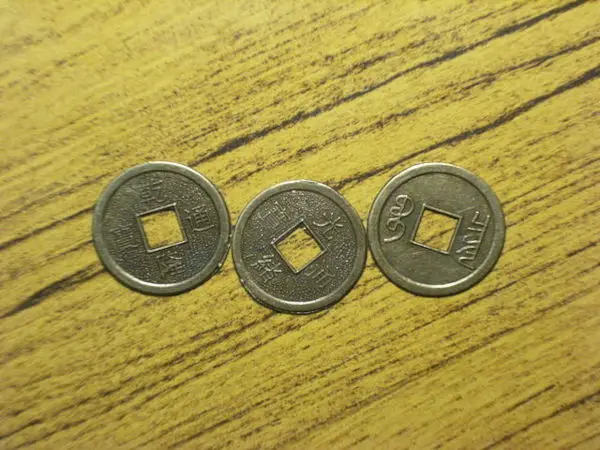
Reading Shells and Bones
Plastromancy, or the reading of turtle shell oracles, was one of the first ways of fortune-telling. When ox scapula bones were used instead, the proper term was scapulimancy.
It was common practice for diviners to ask inquiries about upcoming harvests, the state of the weather, the success of military endeavors, and other issues, and then carve them into shells or bones and apply heat to them with metal rods. The material would fracture, and the diviner would examine the patterns in the cracks, interpret them, and write their prediction on the piece as well.
Especially after the discovery of an oracle bone excavation site in Henan in 1928, which showed that divination was done for or by the royal household of the Shang dynasty, these oracle bones, which have the earliest known collection of ancient Chinese writing, were helpful to Chinese historians.
This type of divination was called卜 (bǔ), which could be a picture of the cracks or a description of the sound the material made when it broke. This kind of divination is still used today under the term, 占卜 (zhānbǔ).

Purple Star Astrology
A significant but less well-known technique is Zi Wei Dou Shu (紫薇斗数), or “Purple Star Astrology.” The fortune teller uses a person’s Chinese calendar-based birthday, the twelve Chinese constellations, the four pillars of destiny, and the five elements to make a life map that shows a person’s destiny and future relationships.
Similar to western astrology, this method says that it can figure out a person’s fate by looking at where the stars were when he was born.
The fortune teller’s final prediction is highly dependent on the accuracy of the initial four pillars you supply; therefore, it’s important to be precise at all times. This approach also discloses and validates events that are currently occurring in your life or may have occurred in the past.
Chinese Fortune Telling Cards
Many people are fascinated by Chinese fortune-telling cards. They are based on the Oracle Bones Script, a pre-historic Chinese divination method. This divination technique is based on mystical Shang Dynasty inscriptions, and it aims to modernize and simplify a few issues in life that are allegedly difficult to comprehend.
The deck is frequently used for direct divination or as the most important way of acquiring knowledge of or insights into various circumstances and concerns. The guidance offered by Chinese tarot cards is straightforward and can be interpreted in a variety of ways. After consulting the fortune teller, you will have a clear understanding of the scenario to which the advice must be applied, but it is up to you to determine whether or not to follow through on the advice.
The Chinese fortune cards are known for their elaborate and vivid artwork, which often depicts mythical creatures, historical figures, and commonplace objects. The illustrations are correctly impressed on the cards and feature moon maidens, fishing scenes, red paper lanterns, Buddha statues, Feng Shui coins, a pagoda, foodstuffs, and cartoon figures. All of these have a distinct message that must be deciphered by the fortune teller.
Overall, the Chinese Fortune Telling Cards is a well-known and highly regarded divination instrument that includes thirty-six cards and a full handbook based on ancient Chinese philosophies and teachings for modern-day circumstances and difficulties. Each card in the deck provides a life-improving Feng Shui tip or suggestion to improve your quality of life, assist you in making wiser choices, and put you on a smooth path to happiness.
Whether you want to know about the future of your business, the next step in your profession, the ideal time to take a trip, your romantic prospects, or how to resolve an argument, the fortune teller is there to answer your queries.

Who are the Chinese fortune tellers?
Fortune telling is a thriving industry that comes in various forms and levels. Fortune tellers can enjoy great social status, particularly those who work with government officials and major bosses. Wealthy and powerful people have used fortune-telling throughout Chinese history. According to J.P. Morgan, “Millionaires don’t use astrology, billionaires do.”
Of course, not all fortune tellers serve wealthy clients, so there are different kinds. There are fortune tellers who practice without speaking, those whose entire profession revolves around talking, as well as those who need to be attractive, skilled with words, extremely intelligent, and trained expressly to close large commercial deals.
They function similarly to psychologists in that they provide recommendations to help individuals address difficulties. They must also be skilled in statistics, as many “predictions” rely on them. Professional fortune tellers are organized into factions and work under a master-apprentice system. Each faction, like many underground groups, has its own set of rules to follow.
Questions Frequently Asked to Chinese Fortune Tellers
Choosing a partner: When it comes to compatibility, some bazi or zodiac signs are more likely to produce marital strife or, in the worst case, the death of one partner. The term “ke” (克) is frequently used here; for instance, a “kefu ming” (克夫命) is a female who is condemned to be a widow no matter who she marries. Other signs, however, complement each other extremely well, for example, rat and dragon, snake and taurus.
Fortune tellers can tell single people how to make themselves more attractive, find more romantic partners, or avoid unwanted attention.
Choosing a Name: The Chinese are superstitious, and they think that a good name may bring good fortune and personal development. Because of this, a lot of parents use fortune tellers to choose or alter their child’s name, and celebrities are eager to switch their stage names in order to become more successful.
Finance and Career: People who must make significant professional decisions frequently consult fortune tellers for guidance. They are allegedly able to determine if your profession is progressing, who will advance it and can be trusted (贵人 – gui ren), and who should be avoided at all costs (小人 – xiao ren). Again, there’s more psychology at play here than magic.
Health: To a greater extent than the others, this one may be supported by science, as one’s state of health is typically discernible from their outward appearance. However, many Chinese fortune tellers use their bazi, or zi wei dou shu, to forecast or diagnose their customers’ health. This is all based on an extremely sophisticated system that incorporates Chinese constellations and the four pillars of fate.

Why Are There So Many Chinese Blind Fortune Tellers?
Films and literature frequently depict fortune tellers as blind, and many of them will claim that they lost their vision because they revealed the secrets of heaven and were punished by God. Because they can’t see physical characteristics, their blindness might work in their favor when convincing clients of their accuracy.
Perhaps this isn’t complete gibberish. Numerous fortune-telling techniques and concepts are mainly reliant on memory and the demand for a “peaceful heart.” Since they can’t see, blind people can focus and do calculations well, which makes them good candidates for studying and passing on ways to predict the future. The blind faction is another major group in the Chinese master-apprentice system for fortune telling.
Another factor is, of course, the fact that blind people still need to earn a livelihood, which is why they train to be fortune tellers.
How to Locate Chinese Fortune Tellers
Fortune tellers may be found in temples all around China. For example, fortune stick readers are commonly found in temples, where monks would provide readings as well as read faces and palms. On the other hand, most people who know about Feng Shui and Bazi are experienced freelancers who see clients one-on-one.
Additionally, large night markets and temple festivals before the new year are other locations to find fortune tellers.
If you are in China, it will be easy to find a fortune-teller, but be aware that because to the popularity and widespread availability of fortune-telling, there are many charlatans around. They’ll generally foresee your doom and then try to offer you an expensive remedy.
The easiest approach to discovering a reliable fortune teller is to ask your Chinese friends.
Check out our “Free Culture Library“. We have compiled some great free resources, about Chinese culture, for your research.
What to Pay at Chinese Fortune Tellers
Depending on how expert the reader is, you can expect to pay more than 100 yuan for a reading. A complete Bazi suite will cost between 500 and 1000 yuan. This will give you a long report about your current life, your past, and your predictions for the future, along with tips on how to change the way you act. However, there are instances where consumers are prepared to pay more to fortune-tellers if they are pleased with the outcome.
Prices will be less expensive if you do it at a market, but more expensive if you do it at a temple. They also vary according to the local cost of living. But don’t forget to bargain.
If someone approaches you and takes your hand at a temple, don’t be surprised. These are the palm readers who read your fortune. Of course, you are under no obligation to use their services if you don’t feel comfortable doing so.
Final Thoughts
Throughout its history, Chinese society has placed its faith in fate during times of crisis, necessity, and ambiguity. This has been done both in the pursuit of solutions and in response to these situations. Modern Chinese society holds fortune-telling in high regard and sees it as an important part of both their social and business culture.
Lastly, I want to close this article with a famous Chinese fortune-teller’s maxim.
“First fate, second luck, third feng shui, fourth cultivate good merits, fifth education, sixth name, seventh face, eighth, honor the Gods, ninth relationships with high-ranking men, and tenth, live a healthy life.”
“一命二运三风水四积阴德五读书 六名七相八敬神九交贵人十养生”
Online Courses about Chinese Culture from Udemy (Aff.link)
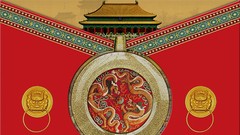
Stay in Touch
 Join our newsletter by using the forms on this website or click here!
Join our newsletter by using the forms on this website or click here! Follow us on Google News
Follow us on Google News Follow us on Facebook
Follow us on Facebook

